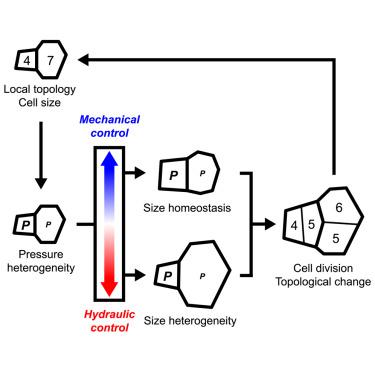当前位置:
X-MOL 学术
›
Curr. Biol.
›
论文详情
Our official English website, www.x-mol.net, welcomes your feedback! (Note: you will need to create a separate account there.)
Cellular Heterogeneity in Pressure and Growth Emerges from Tissue Topology and Geometry.
Current Biology ( IF 9.2 ) Pub Date : 2020-03-12 , DOI: 10.1016/j.cub.2020.02.027 Yuchen Long 1 , Ibrahim Cheddadi 2 , Gabriella Mosca 3 , Vincent Mirabet 4 , Mathilde Dumond 1 , Annamaria Kiss 1 , Jan Traas 1 , Christophe Godin 1 , Arezki Boudaoud 1
Current Biology ( IF 9.2 ) Pub Date : 2020-03-12 , DOI: 10.1016/j.cub.2020.02.027 Yuchen Long 1 , Ibrahim Cheddadi 2 , Gabriella Mosca 3 , Vincent Mirabet 4 , Mathilde Dumond 1 , Annamaria Kiss 1 , Jan Traas 1 , Christophe Godin 1 , Arezki Boudaoud 1
Affiliation

|
Cell-to-cell heterogeneity prevails in many systems, as exemplified by cell growth, although the origin and function of such heterogeneity are often unclear. In plants, growth is physically controlled by cell wall mechanics and cell hydrostatic pressure, alias turgor pressure. Whereas cell wall heterogeneity has received extensive attention, the spatial variation of turgor pressure is often overlooked. Here, combining atomic force microscopy and a physical model of pressurized cells, we show that turgor pressure is heterogeneous in the Arabidopsis shoot apical meristem, a population of stem cells that generates all plant aerial organs. In contrast with cell wall mechanical properties that appear to vary stochastically between neighboring cells, turgor pressure anticorrelates with cell size and cell neighbor number (local topology), in agreement with the prediction by our model of tissue expansion, which couples cell wall mechanics and tissue hydraulics. Additionally, our model predicts two types of correlations between pressure and cellular growth rate, where high pressure may lead to faster- or slower-than-average growth, depending on cell wall extensibility, yield threshold, osmotic pressure, and hydraulic conductivity. The meristem exhibits one of these two regimes, depending on conditions, suggesting that, in this tissue, water conductivity may contribute to growth control. Our results unravel cell pressure as a source of patterned heterogeneity and illustrate links between local topology, cell mechanical state, and cell growth, with potential roles in tissue homeostasis.
中文翻译:

压力和生长中的细胞异质性来自组织拓扑和几何形状。
细胞间异质性在许多系统中普遍存在,以细胞生长为例,尽管这种异质性的起源和功能通常不清楚。在植物中,生长受到细胞壁力学和细胞静水压力(别名膨胀压力)的物理控制。尽管细胞壁的异质性受到了广泛关注,但是膨胀压力的空间变化却常常被忽略。在这里,结合原子力显微镜和加压细胞的物理模型,我们显示了拟南芥芽顶端分生组织中的膨大压力是异质的,后者是产生所有植物空中器官的干细胞群体。与相邻细胞之间的细胞壁机械性能似乎随机变化相比,膨胀压力与细胞大小和细胞邻居数(局部拓扑)反相关,与我们的组织扩张模型(细胞壁力学和组织水力学相结合)的预测相符。此外,我们的模型预测了压力与细胞生长速率之间的两种相关性,其中高压可能导致比平均速度快或慢的生长,具体取决于细胞壁的可延展性,屈服阈值,渗透压和水力传导率。分生组织表现出这两种方案之一,具体取决于条件,这表明在该组织中,水的电导率可能有助于生长控制。我们的研究结果揭示了细胞压力是图案异质性的来源,并说明了局部拓扑结构,细胞机械状态和细胞生长之间的联系,并可能在组织动态平衡中发挥作用。结合了细胞壁力学和组织液压学。此外,我们的模型预测了压力与细胞生长速率之间的两种相关性,其中高压可能导致比平均速度快或慢的生长,具体取决于细胞壁的可延展性,屈服阈值,渗透压和水力传导率。分生组织表现出这两种方案之一,具体取决于条件,这表明在该组织中,水的电导率可能有助于生长控制。我们的研究结果揭示了细胞压力是图案异质性的来源,并说明了局部拓扑结构,细胞机械状态和细胞生长之间的联系,并可能在组织动态平衡中发挥作用。结合了细胞壁力学和组织液压学。此外,我们的模型预测压力和细胞生长速率之间的两种相关性,其中高压可能导致比平均速度快或慢的生长,具体取决于细胞壁的可扩展性,屈服阈值,渗透压和水力传导率。分生组织表现出这两种方案之一,具体取决于条件,这表明在该组织中,水的电导率可能有助于生长控制。我们的研究结果揭示了细胞压力是图案异质性的来源,并说明了局部拓扑结构,细胞机械状态和细胞生长之间的联系,并可能在组织动态平衡中发挥作用。高压可能会导致生长速度快于或慢于平均水平,具体取决于细胞壁的可扩展性,屈服极限,渗透压和水力传导率。分生组织表现出这两种方案之一,具体取决于条件,这表明在该组织中,水的电导率可能有助于生长控制。我们的研究结果揭示了细胞压力是图案异质性的来源,并说明了局部拓扑结构,细胞机械状态和细胞生长之间的联系,并可能在组织动态平衡中发挥作用。高压可能会导致生长速度快于或慢于平均水平,具体取决于细胞壁的可扩展性,屈服极限,渗透压和水力传导率。分生组织表现出这两种方案之一,具体取决于条件,这表明在该组织中,水的电导率可能有助于生长控制。我们的研究结果揭示了细胞压力是图案异质性的来源,并说明了局部拓扑结构,细胞机械状态和细胞生长之间的联系,并可能在组织动态平衡中发挥作用。
更新日期:2020-04-20
中文翻译:

压力和生长中的细胞异质性来自组织拓扑和几何形状。
细胞间异质性在许多系统中普遍存在,以细胞生长为例,尽管这种异质性的起源和功能通常不清楚。在植物中,生长受到细胞壁力学和细胞静水压力(别名膨胀压力)的物理控制。尽管细胞壁的异质性受到了广泛关注,但是膨胀压力的空间变化却常常被忽略。在这里,结合原子力显微镜和加压细胞的物理模型,我们显示了拟南芥芽顶端分生组织中的膨大压力是异质的,后者是产生所有植物空中器官的干细胞群体。与相邻细胞之间的细胞壁机械性能似乎随机变化相比,膨胀压力与细胞大小和细胞邻居数(局部拓扑)反相关,与我们的组织扩张模型(细胞壁力学和组织水力学相结合)的预测相符。此外,我们的模型预测了压力与细胞生长速率之间的两种相关性,其中高压可能导致比平均速度快或慢的生长,具体取决于细胞壁的可延展性,屈服阈值,渗透压和水力传导率。分生组织表现出这两种方案之一,具体取决于条件,这表明在该组织中,水的电导率可能有助于生长控制。我们的研究结果揭示了细胞压力是图案异质性的来源,并说明了局部拓扑结构,细胞机械状态和细胞生长之间的联系,并可能在组织动态平衡中发挥作用。结合了细胞壁力学和组织液压学。此外,我们的模型预测了压力与细胞生长速率之间的两种相关性,其中高压可能导致比平均速度快或慢的生长,具体取决于细胞壁的可延展性,屈服阈值,渗透压和水力传导率。分生组织表现出这两种方案之一,具体取决于条件,这表明在该组织中,水的电导率可能有助于生长控制。我们的研究结果揭示了细胞压力是图案异质性的来源,并说明了局部拓扑结构,细胞机械状态和细胞生长之间的联系,并可能在组织动态平衡中发挥作用。结合了细胞壁力学和组织液压学。此外,我们的模型预测压力和细胞生长速率之间的两种相关性,其中高压可能导致比平均速度快或慢的生长,具体取决于细胞壁的可扩展性,屈服阈值,渗透压和水力传导率。分生组织表现出这两种方案之一,具体取决于条件,这表明在该组织中,水的电导率可能有助于生长控制。我们的研究结果揭示了细胞压力是图案异质性的来源,并说明了局部拓扑结构,细胞机械状态和细胞生长之间的联系,并可能在组织动态平衡中发挥作用。高压可能会导致生长速度快于或慢于平均水平,具体取决于细胞壁的可扩展性,屈服极限,渗透压和水力传导率。分生组织表现出这两种方案之一,具体取决于条件,这表明在该组织中,水的电导率可能有助于生长控制。我们的研究结果揭示了细胞压力是图案异质性的来源,并说明了局部拓扑结构,细胞机械状态和细胞生长之间的联系,并可能在组织动态平衡中发挥作用。高压可能会导致生长速度快于或慢于平均水平,具体取决于细胞壁的可扩展性,屈服极限,渗透压和水力传导率。分生组织表现出这两种方案之一,具体取决于条件,这表明在该组织中,水的电导率可能有助于生长控制。我们的研究结果揭示了细胞压力是图案异质性的来源,并说明了局部拓扑结构,细胞机械状态和细胞生长之间的联系,并可能在组织动态平衡中发挥作用。



























 京公网安备 11010802027423号
京公网安备 11010802027423号